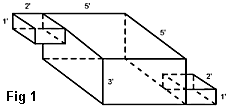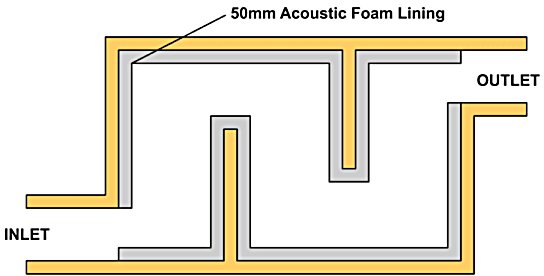Quiet Ventilation Tips
Quiet Ventilation Tips
If you have a soundproofed room you will either have to open the doors periodically to let fresh air in or you will want to install some form of fresh air supply.
Commercial systems often increase the overall budget considerably so below are a few tips to help you if you wish to construct a fairly efficient DIY system.
Soundproofing fans
The first thing to remember is that large fans are quieter than small fans and that centrifugal fans are quieter than axial fans.
Choosing a more suitable fan over a noisy one will help from the start.
The lowest possible airflow velocity with the largest possible duct size is what will eventually produce the quietest results.
Reducing the air velocity in a ventilation system can lower the noise output by up to 20dB or a 1/4 of the perceived loudness.

Sound reducing plenum chamber for HVAC
A sound absorbing plenum chamber (Fig. 1) is an economical device which can achieve significant noise attenuation in an air supply system.
This type of plenum with a 50mm thick acoustic lining will give around 20dB of attenuation down to about 500Hz.
If the unit was lined with 100mm thick material that figure would be uniform to about 100Hz.

The performance of a chamber like this can be increased by increasing the ratio of the cross-sectional area of the inlet and outlet ducts with that of the chamber itself.
Increasing the thickness of the lining will also produce additional performance benefits.
The unit should ideally be located at the fan discharge to reduce the noise entering the duct system.
Ducting
The internal walls of a duct system should be smooth to reduce air turbulence which causes additional noise.
The duct layout should be simple with a minimum of branches. Round corners should be used over square corners with as large a radius as possible to minimise noise turbulence.
Flaring the intake and outlet openings can substantially reduce noise.
Flexible couplings should also be used to reduce fan noise transfer to structural elements.
As well as lining a duct to reduce internal noise it should also be remembered that external noise will try to get into the duct.
This can be reduced by covering the exterior of the ductwork with a foam spaced heavy barrier.
Ducts can also transmit sound between rooms very effectively.
The most ideal solution is to use separate ducts to feed each room and if that is not possible then at least position the ducts as far away from each other as possible.
A suitable acoustic foam duct lining material is the fire retardent Duct Foam. It’s best not to use fibreglass type materials due to fibre migration.
Our duct lining foam is also known by other names such as Barofoam, Barafoam, PUNF foam, Pyrsosorb foam and Fireseal foam.
A simple DIY baffle is shown below. Best results will be achieved if an inlet baffle is positioned at the bottom of one wall and an outlet baffle is positioned at the top of the opposing wall.

Airflow
Turbulent airflow through duct work can generate significant levels of noise.
Generally this aerodynamic noise is in the region of 200Hz to 2kHz.
Airflow generated noise gets louder as the air velocity gets faster.
For every doubling of airflow the noise level at the outlet will increase by around 16dB. This is why air flow velocities should be as low as possible. To achieve this will require large cross-sectional area duct work.
